Operations Management: Review, Critique, and Improvement Plan Report
VerifiedAdded on 2023/06/18
|23
|5956
|499
Report
AI Summary
This report provides a comprehensive review and critique of operations management principles, focusing on AstraZeneca as a case study. It begins by introducing AstraZeneca and differentiating between operations and operations management. The report then reviews the implementation of lean production, mass customization, and agile manufacturing within AstraZeneca, highlighting the pros and cons of each. An analysis is conducted to determine how well AstraZeneca's operations management meets organizational requirements, emphasizing the use of lean production, mass customization, and agile manufacturing. The report also discusses continuous improvement as a philosophy, detailing lean principles such as defining value, mapping the value stream, creating flow, establishing pull, and pursuing perfection, along with Six Sigma strategies. Finally, a continuous improvement plan is proposed, incorporating the Kaizen framework and the PDCA cycle, to facilitate ongoing process enhancements within the organization. Desklib offers a wide range of solved assignments and study tools for students.
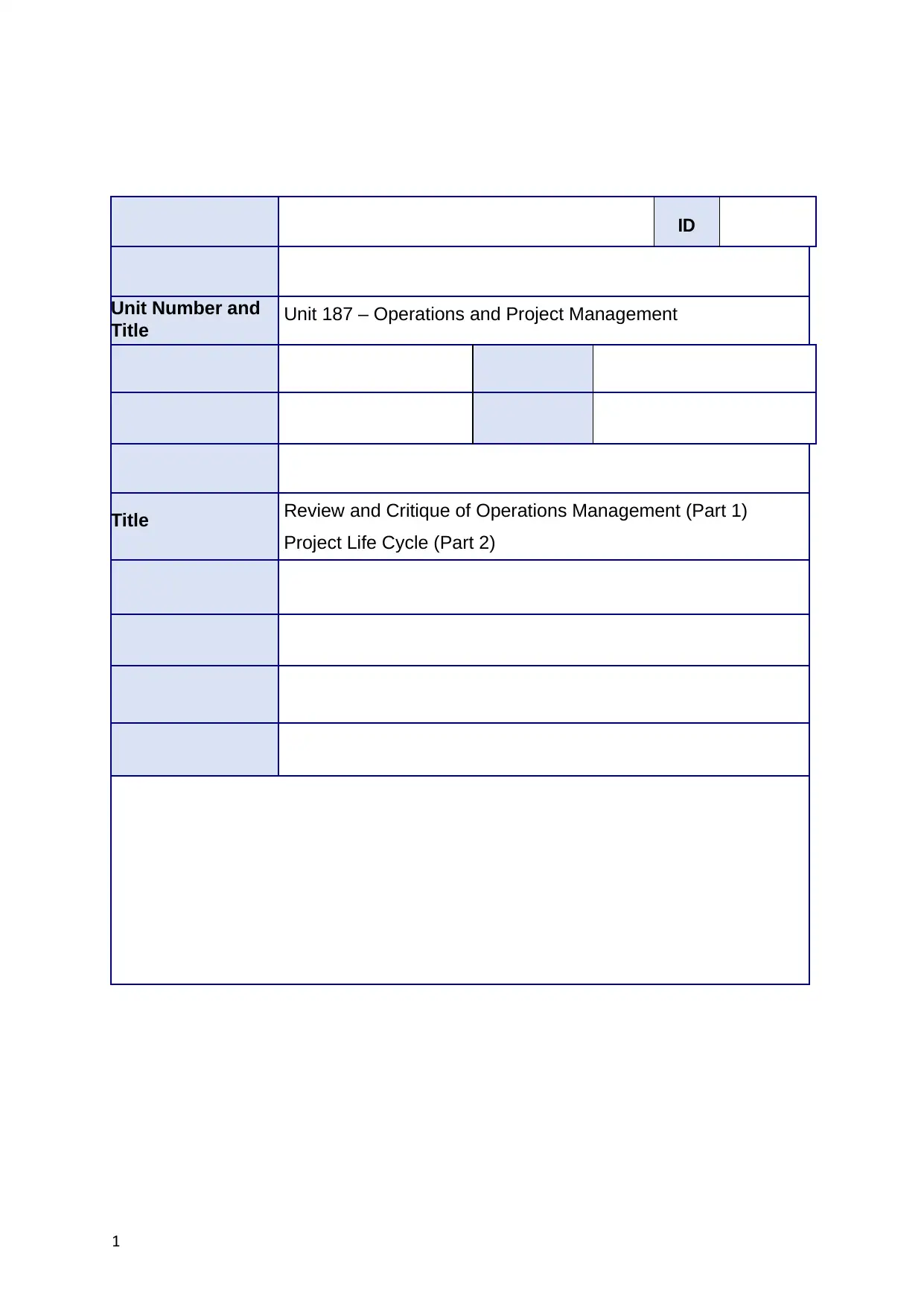
ID
Unit Number and
Title Unit 187 – Operations and Project Management
Title Review and Critique of Operations Management (Part 1)
Project Life Cycle (Part 2)
1
Unit Number and
Title Unit 187 – Operations and Project Management
Title Review and Critique of Operations Management (Part 1)
Project Life Cycle (Part 2)
1
Paraphrase This Document
Need a fresh take? Get an instant paraphrase of this document with our AI Paraphraser
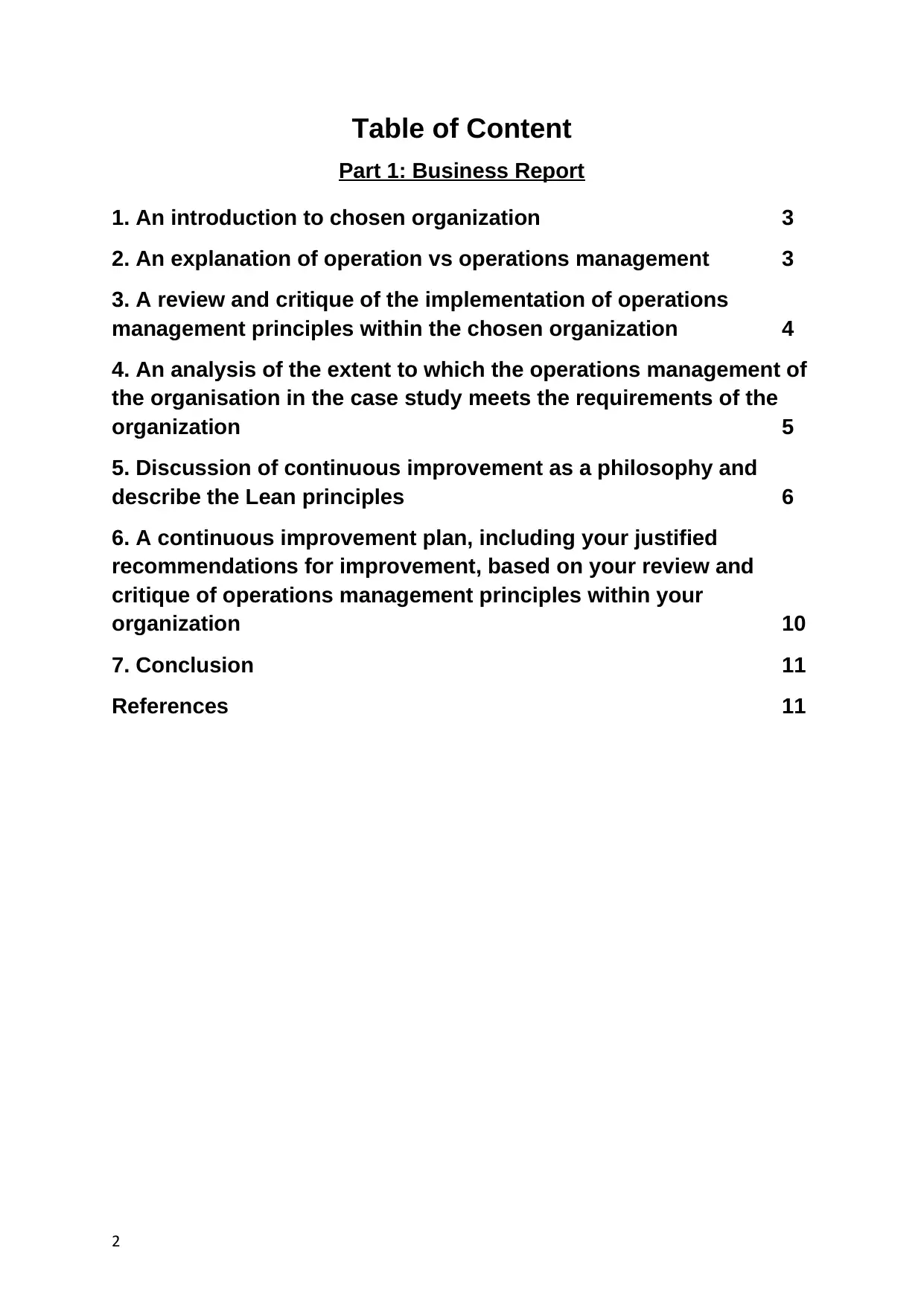
Table of Content
Part 1: Business Report
1. An introduction to chosen organization 3
2. An explanation of operation vs operations management 3
3. A review and critique of the implementation of operations
management principles within the chosen organization 4
4. An analysis of the extent to which the operations management of
the organisation in the case study meets the requirements of the
organization 5
5. Discussion of continuous improvement as a philosophy and
describe the Lean principles 6
6. A continuous improvement plan, including your justified
recommendations for improvement, based on your review and
critique of operations management principles within your
organization 10
7. Conclusion 11
References 11
2
Part 1: Business Report
1. An introduction to chosen organization 3
2. An explanation of operation vs operations management 3
3. A review and critique of the implementation of operations
management principles within the chosen organization 4
4. An analysis of the extent to which the operations management of
the organisation in the case study meets the requirements of the
organization 5
5. Discussion of continuous improvement as a philosophy and
describe the Lean principles 6
6. A continuous improvement plan, including your justified
recommendations for improvement, based on your review and
critique of operations management principles within your
organization 10
7. Conclusion 11
References 11
2
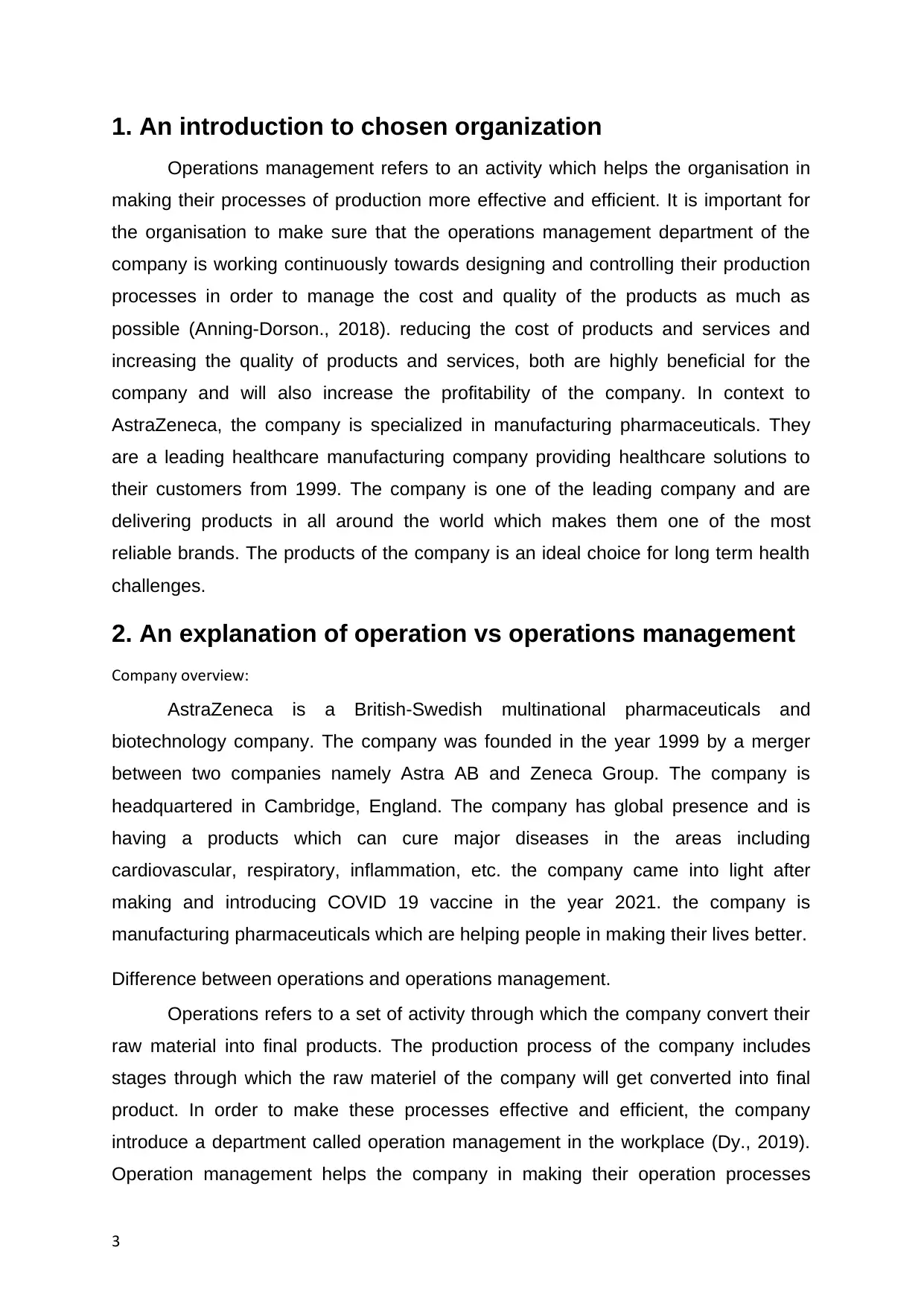
1. An introduction to chosen organization
Operations management refers to an activity which helps the organisation in
making their processes of production more effective and efficient. It is important for
the organisation to make sure that the operations management department of the
company is working continuously towards designing and controlling their production
processes in order to manage the cost and quality of the products as much as
possible (Anning-Dorson., 2018). reducing the cost of products and services and
increasing the quality of products and services, both are highly beneficial for the
company and will also increase the profitability of the company. In context to
AstraZeneca, the company is specialized in manufacturing pharmaceuticals. They
are a leading healthcare manufacturing company providing healthcare solutions to
their customers from 1999. The company is one of the leading company and are
delivering products in all around the world which makes them one of the most
reliable brands. The products of the company is an ideal choice for long term health
challenges.
2. An explanation of operation vs operations management
Company overview:
AstraZeneca is a British-Swedish multinational pharmaceuticals and
biotechnology company. The company was founded in the year 1999 by a merger
between two companies namely Astra AB and Zeneca Group. The company is
headquartered in Cambridge, England. The company has global presence and is
having a products which can cure major diseases in the areas including
cardiovascular, respiratory, inflammation, etc. the company came into light after
making and introducing COVID 19 vaccine in the year 2021. the company is
manufacturing pharmaceuticals which are helping people in making their lives better.
Difference between operations and operations management.
Operations refers to a set of activity through which the company convert their
raw material into final products. The production process of the company includes
stages through which the raw materiel of the company will get converted into final
product. In order to make these processes effective and efficient, the company
introduce a department called operation management in the workplace (Dy., 2019).
Operation management helps the company in making their operation processes
3
Operations management refers to an activity which helps the organisation in
making their processes of production more effective and efficient. It is important for
the organisation to make sure that the operations management department of the
company is working continuously towards designing and controlling their production
processes in order to manage the cost and quality of the products as much as
possible (Anning-Dorson., 2018). reducing the cost of products and services and
increasing the quality of products and services, both are highly beneficial for the
company and will also increase the profitability of the company. In context to
AstraZeneca, the company is specialized in manufacturing pharmaceuticals. They
are a leading healthcare manufacturing company providing healthcare solutions to
their customers from 1999. The company is one of the leading company and are
delivering products in all around the world which makes them one of the most
reliable brands. The products of the company is an ideal choice for long term health
challenges.
2. An explanation of operation vs operations management
Company overview:
AstraZeneca is a British-Swedish multinational pharmaceuticals and
biotechnology company. The company was founded in the year 1999 by a merger
between two companies namely Astra AB and Zeneca Group. The company is
headquartered in Cambridge, England. The company has global presence and is
having a products which can cure major diseases in the areas including
cardiovascular, respiratory, inflammation, etc. the company came into light after
making and introducing COVID 19 vaccine in the year 2021. the company is
manufacturing pharmaceuticals which are helping people in making their lives better.
Difference between operations and operations management.
Operations refers to a set of activity through which the company convert their
raw material into final products. The production process of the company includes
stages through which the raw materiel of the company will get converted into final
product. In order to make these processes effective and efficient, the company
introduce a department called operation management in the workplace (Dy., 2019).
Operation management helps the company in making their operation processes
3
⊘ This is a preview!⊘
Do you want full access?
Subscribe today to unlock all pages.

Trusted by 1+ million students worldwide
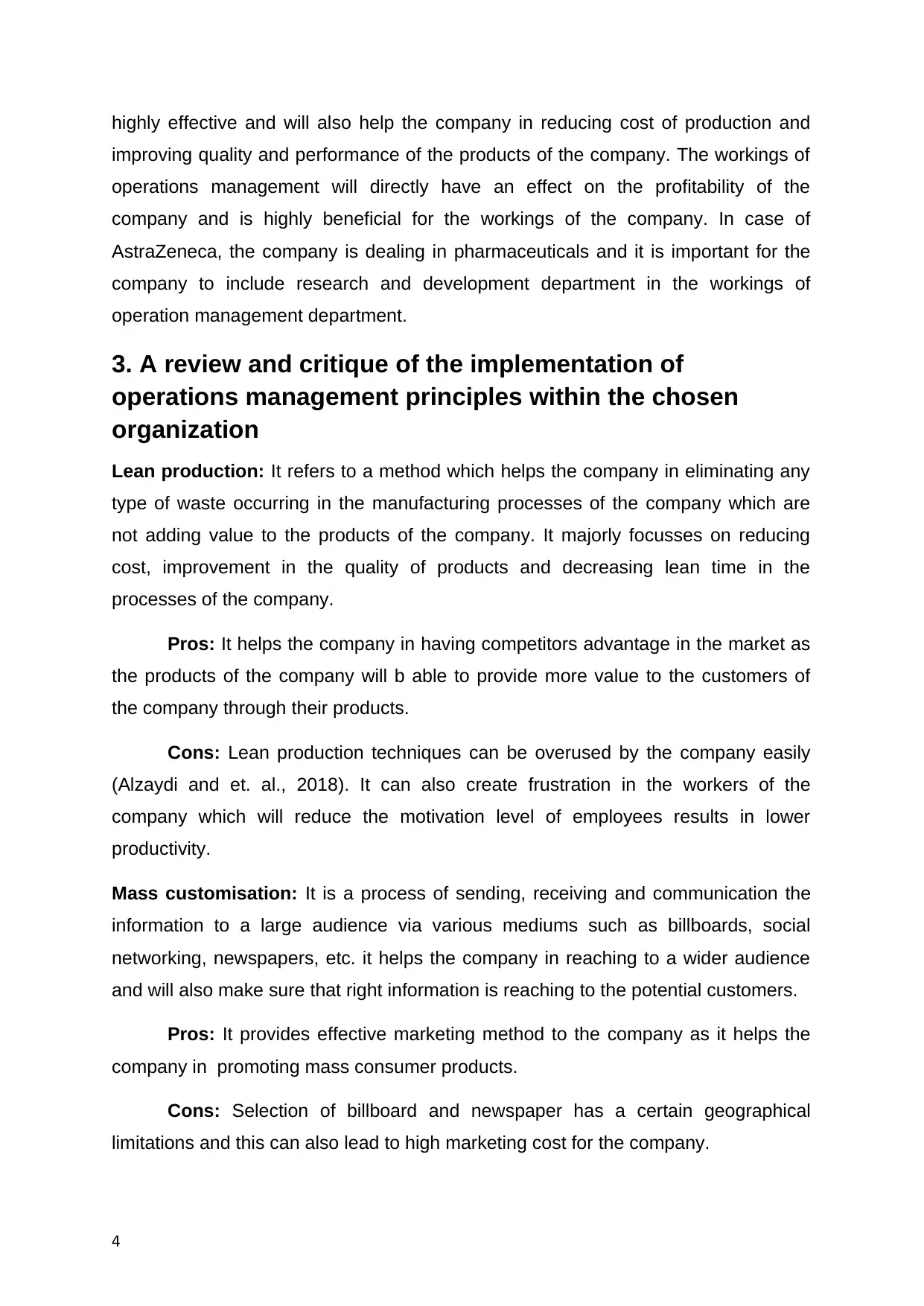
highly effective and will also help the company in reducing cost of production and
improving quality and performance of the products of the company. The workings of
operations management will directly have an effect on the profitability of the
company and is highly beneficial for the workings of the company. In case of
AstraZeneca, the company is dealing in pharmaceuticals and it is important for the
company to include research and development department in the workings of
operation management department.
3. A review and critique of the implementation of
operations management principles within the chosen
organization
Lean production: It refers to a method which helps the company in eliminating any
type of waste occurring in the manufacturing processes of the company which are
not adding value to the products of the company. It majorly focusses on reducing
cost, improvement in the quality of products and decreasing lean time in the
processes of the company.
Pros: It helps the company in having competitors advantage in the market as
the products of the company will b able to provide more value to the customers of
the company through their products.
Cons: Lean production techniques can be overused by the company easily
(Alzaydi and et. al., 2018). It can also create frustration in the workers of the
company which will reduce the motivation level of employees results in lower
productivity.
Mass customisation: It is a process of sending, receiving and communication the
information to a large audience via various mediums such as billboards, social
networking, newspapers, etc. it helps the company in reaching to a wider audience
and will also make sure that right information is reaching to the potential customers.
Pros: It provides effective marketing method to the company as it helps the
company in promoting mass consumer products.
Cons: Selection of billboard and newspaper has a certain geographical
limitations and this can also lead to high marketing cost for the company.
4
improving quality and performance of the products of the company. The workings of
operations management will directly have an effect on the profitability of the
company and is highly beneficial for the workings of the company. In case of
AstraZeneca, the company is dealing in pharmaceuticals and it is important for the
company to include research and development department in the workings of
operation management department.
3. A review and critique of the implementation of
operations management principles within the chosen
organization
Lean production: It refers to a method which helps the company in eliminating any
type of waste occurring in the manufacturing processes of the company which are
not adding value to the products of the company. It majorly focusses on reducing
cost, improvement in the quality of products and decreasing lean time in the
processes of the company.
Pros: It helps the company in having competitors advantage in the market as
the products of the company will b able to provide more value to the customers of
the company through their products.
Cons: Lean production techniques can be overused by the company easily
(Alzaydi and et. al., 2018). It can also create frustration in the workers of the
company which will reduce the motivation level of employees results in lower
productivity.
Mass customisation: It is a process of sending, receiving and communication the
information to a large audience via various mediums such as billboards, social
networking, newspapers, etc. it helps the company in reaching to a wider audience
and will also make sure that right information is reaching to the potential customers.
Pros: It provides effective marketing method to the company as it helps the
company in promoting mass consumer products.
Cons: Selection of billboard and newspaper has a certain geographical
limitations and this can also lead to high marketing cost for the company.
4
Paraphrase This Document
Need a fresh take? Get an instant paraphrase of this document with our AI Paraphraser
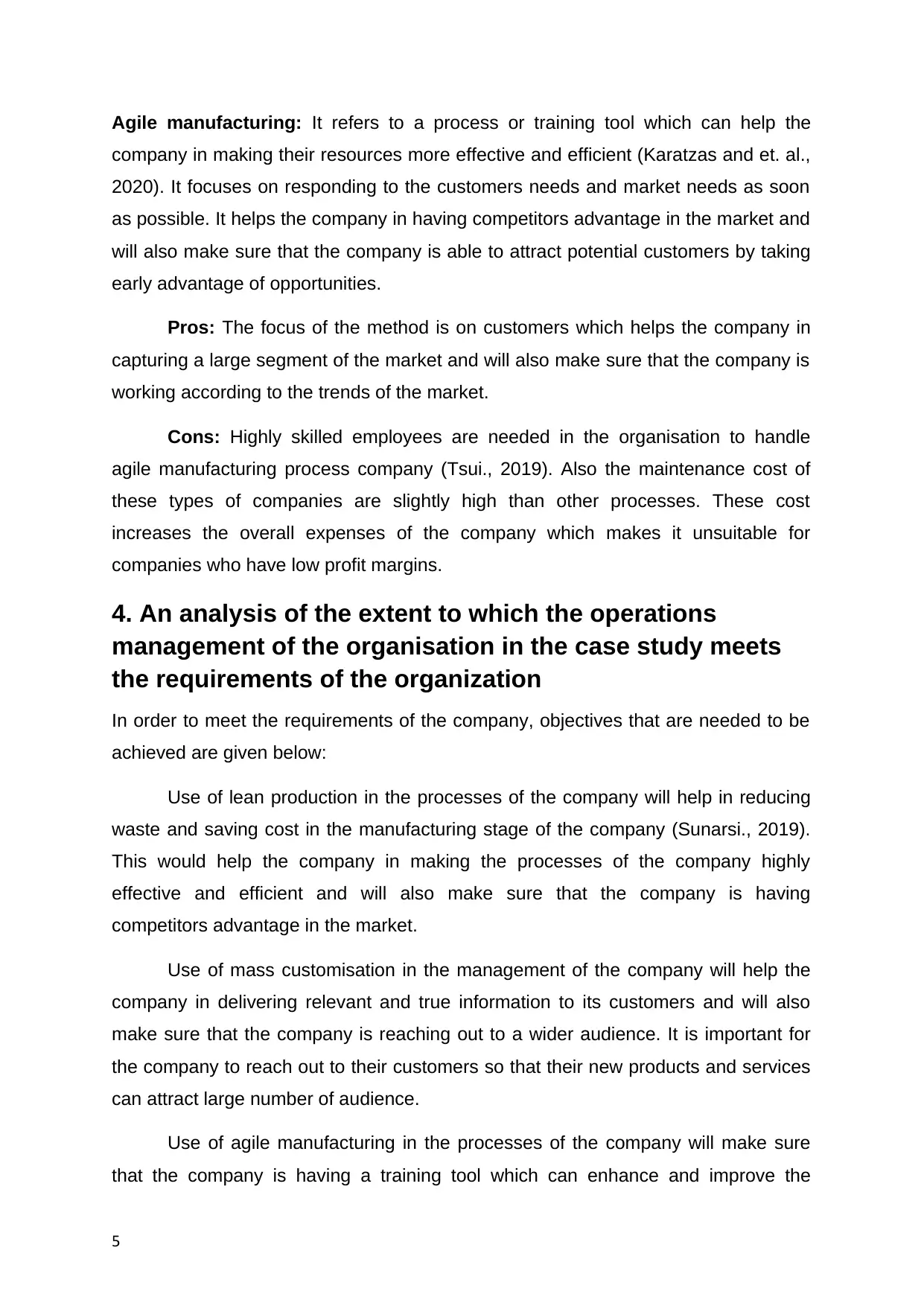
Agile manufacturing: It refers to a process or training tool which can help the
company in making their resources more effective and efficient (Karatzas and et. al.,
2020). It focuses on responding to the customers needs and market needs as soon
as possible. It helps the company in having competitors advantage in the market and
will also make sure that the company is able to attract potential customers by taking
early advantage of opportunities.
Pros: The focus of the method is on customers which helps the company in
capturing a large segment of the market and will also make sure that the company is
working according to the trends of the market.
Cons: Highly skilled employees are needed in the organisation to handle
agile manufacturing process company (Tsui., 2019). Also the maintenance cost of
these types of companies are slightly high than other processes. These cost
increases the overall expenses of the company which makes it unsuitable for
companies who have low profit margins.
4. An analysis of the extent to which the operations
management of the organisation in the case study meets
the requirements of the organization
In order to meet the requirements of the company, objectives that are needed to be
achieved are given below:
Use of lean production in the processes of the company will help in reducing
waste and saving cost in the manufacturing stage of the company (Sunarsi., 2019).
This would help the company in making the processes of the company highly
effective and efficient and will also make sure that the company is having
competitors advantage in the market.
Use of mass customisation in the management of the company will help the
company in delivering relevant and true information to its customers and will also
make sure that the company is reaching out to a wider audience. It is important for
the company to reach out to their customers so that their new products and services
can attract large number of audience.
Use of agile manufacturing in the processes of the company will make sure
that the company is having a training tool which can enhance and improve the
5
company in making their resources more effective and efficient (Karatzas and et. al.,
2020). It focuses on responding to the customers needs and market needs as soon
as possible. It helps the company in having competitors advantage in the market and
will also make sure that the company is able to attract potential customers by taking
early advantage of opportunities.
Pros: The focus of the method is on customers which helps the company in
capturing a large segment of the market and will also make sure that the company is
working according to the trends of the market.
Cons: Highly skilled employees are needed in the organisation to handle
agile manufacturing process company (Tsui., 2019). Also the maintenance cost of
these types of companies are slightly high than other processes. These cost
increases the overall expenses of the company which makes it unsuitable for
companies who have low profit margins.
4. An analysis of the extent to which the operations
management of the organisation in the case study meets
the requirements of the organization
In order to meet the requirements of the company, objectives that are needed to be
achieved are given below:
Use of lean production in the processes of the company will help in reducing
waste and saving cost in the manufacturing stage of the company (Sunarsi., 2019).
This would help the company in making the processes of the company highly
effective and efficient and will also make sure that the company is having
competitors advantage in the market.
Use of mass customisation in the management of the company will help the
company in delivering relevant and true information to its customers and will also
make sure that the company is reaching out to a wider audience. It is important for
the company to reach out to their customers so that their new products and services
can attract large number of audience.
Use of agile manufacturing in the processes of the company will make sure
that the company is having a training tool which can enhance and improve the
5
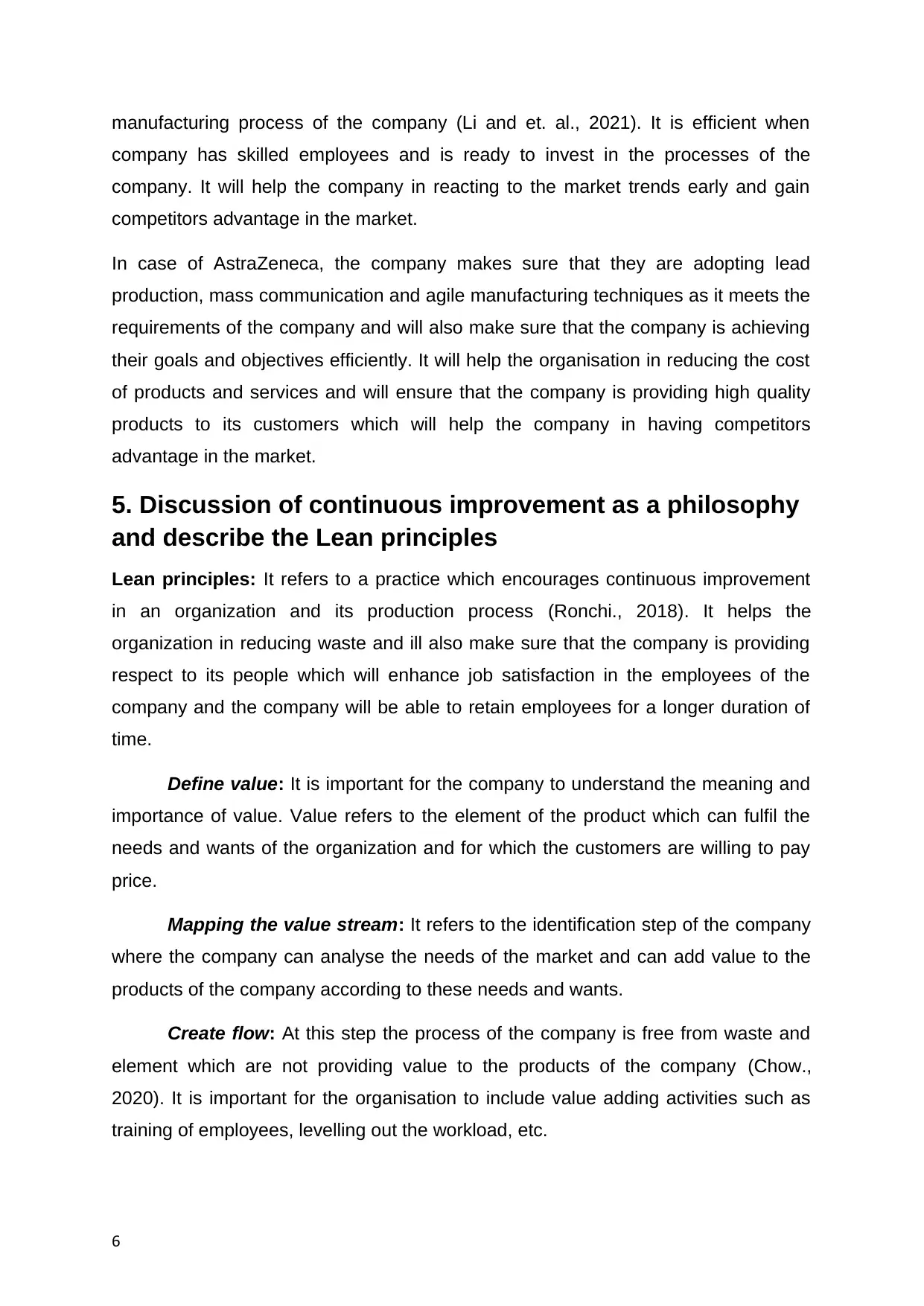
manufacturing process of the company (Li and et. al., 2021). It is efficient when
company has skilled employees and is ready to invest in the processes of the
company. It will help the company in reacting to the market trends early and gain
competitors advantage in the market.
In case of AstraZeneca, the company makes sure that they are adopting lead
production, mass communication and agile manufacturing techniques as it meets the
requirements of the company and will also make sure that the company is achieving
their goals and objectives efficiently. It will help the organisation in reducing the cost
of products and services and will ensure that the company is providing high quality
products to its customers which will help the company in having competitors
advantage in the market.
5. Discussion of continuous improvement as a philosophy
and describe the Lean principles
Lean principles: It refers to a practice which encourages continuous improvement
in an organization and its production process (Ronchi., 2018). It helps the
organization in reducing waste and ill also make sure that the company is providing
respect to its people which will enhance job satisfaction in the employees of the
company and the company will be able to retain employees for a longer duration of
time.
Define value: It is important for the company to understand the meaning and
importance of value. Value refers to the element of the product which can fulfil the
needs and wants of the organization and for which the customers are willing to pay
price.
Mapping the value stream: It refers to the identification step of the company
where the company can analyse the needs of the market and can add value to the
products of the company according to these needs and wants.
Create flow: At this step the process of the company is free from waste and
element which are not providing value to the products of the company (Chow.,
2020). It is important for the organisation to include value adding activities such as
training of employees, levelling out the workload, etc.
6
company has skilled employees and is ready to invest in the processes of the
company. It will help the company in reacting to the market trends early and gain
competitors advantage in the market.
In case of AstraZeneca, the company makes sure that they are adopting lead
production, mass communication and agile manufacturing techniques as it meets the
requirements of the company and will also make sure that the company is achieving
their goals and objectives efficiently. It will help the organisation in reducing the cost
of products and services and will ensure that the company is providing high quality
products to its customers which will help the company in having competitors
advantage in the market.
5. Discussion of continuous improvement as a philosophy
and describe the Lean principles
Lean principles: It refers to a practice which encourages continuous improvement
in an organization and its production process (Ronchi., 2018). It helps the
organization in reducing waste and ill also make sure that the company is providing
respect to its people which will enhance job satisfaction in the employees of the
company and the company will be able to retain employees for a longer duration of
time.
Define value: It is important for the company to understand the meaning and
importance of value. Value refers to the element of the product which can fulfil the
needs and wants of the organization and for which the customers are willing to pay
price.
Mapping the value stream: It refers to the identification step of the company
where the company can analyse the needs of the market and can add value to the
products of the company according to these needs and wants.
Create flow: At this step the process of the company is free from waste and
element which are not providing value to the products of the company (Chow.,
2020). It is important for the organisation to include value adding activities such as
training of employees, levelling out the workload, etc.
6
⊘ This is a preview!⊘
Do you want full access?
Subscribe today to unlock all pages.

Trusted by 1+ million students worldwide
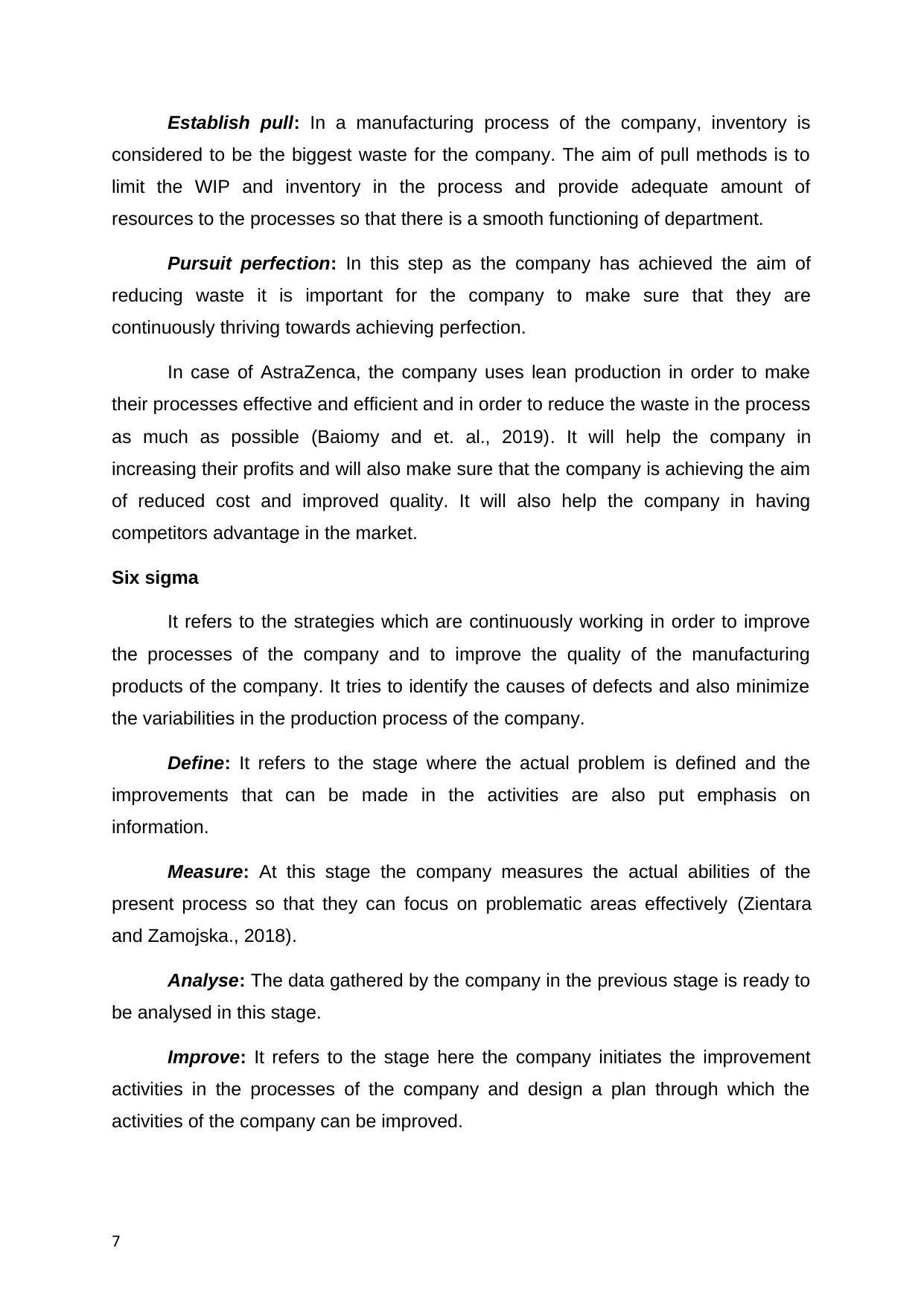
Establish pull: In a manufacturing process of the company, inventory is
considered to be the biggest waste for the company. The aim of pull methods is to
limit the WIP and inventory in the process and provide adequate amount of
resources to the processes so that there is a smooth functioning of department.
Pursuit perfection: In this step as the company has achieved the aim of
reducing waste it is important for the company to make sure that they are
continuously thriving towards achieving perfection.
In case of AstraZenca, the company uses lean production in order to make
their processes effective and efficient and in order to reduce the waste in the process
as much as possible (Baiomy and et. al., 2019). It will help the company in
increasing their profits and will also make sure that the company is achieving the aim
of reduced cost and improved quality. It will also help the company in having
competitors advantage in the market.
Six sigma
It refers to the strategies which are continuously working in order to improve
the processes of the company and to improve the quality of the manufacturing
products of the company. It tries to identify the causes of defects and also minimize
the variabilities in the production process of the company.
Define: It refers to the stage where the actual problem is defined and the
improvements that can be made in the activities are also put emphasis on
information.
Measure: At this stage the company measures the actual abilities of the
present process so that they can focus on problematic areas effectively (Zientara
and Zamojska., 2018).
Analyse: The data gathered by the company in the previous stage is ready to
be analysed in this stage.
Improve: It refers to the stage here the company initiates the improvement
activities in the processes of the company and design a plan through which the
activities of the company can be improved.
7
considered to be the biggest waste for the company. The aim of pull methods is to
limit the WIP and inventory in the process and provide adequate amount of
resources to the processes so that there is a smooth functioning of department.
Pursuit perfection: In this step as the company has achieved the aim of
reducing waste it is important for the company to make sure that they are
continuously thriving towards achieving perfection.
In case of AstraZenca, the company uses lean production in order to make
their processes effective and efficient and in order to reduce the waste in the process
as much as possible (Baiomy and et. al., 2019). It will help the company in
increasing their profits and will also make sure that the company is achieving the aim
of reduced cost and improved quality. It will also help the company in having
competitors advantage in the market.
Six sigma
It refers to the strategies which are continuously working in order to improve
the processes of the company and to improve the quality of the manufacturing
products of the company. It tries to identify the causes of defects and also minimize
the variabilities in the production process of the company.
Define: It refers to the stage where the actual problem is defined and the
improvements that can be made in the activities are also put emphasis on
information.
Measure: At this stage the company measures the actual abilities of the
present process so that they can focus on problematic areas effectively (Zientara
and Zamojska., 2018).
Analyse: The data gathered by the company in the previous stage is ready to
be analysed in this stage.
Improve: It refers to the stage here the company initiates the improvement
activities in the processes of the company and design a plan through which the
activities of the company can be improved.
7
Paraphrase This Document
Need a fresh take? Get an instant paraphrase of this document with our AI Paraphraser
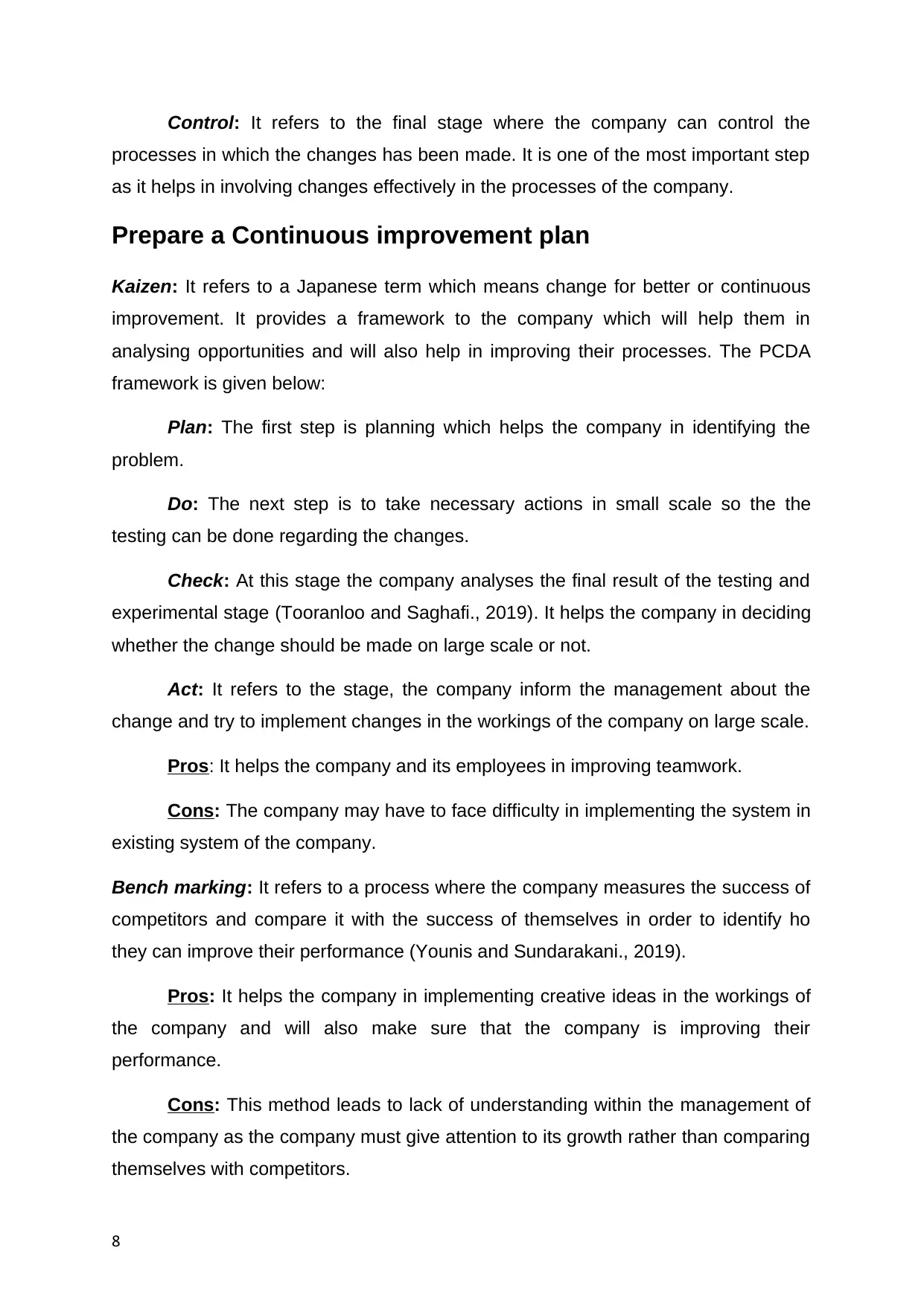
Control: It refers to the final stage where the company can control the
processes in which the changes has been made. It is one of the most important step
as it helps in involving changes effectively in the processes of the company.
Prepare a Continuous improvement plan
Kaizen: It refers to a Japanese term which means change for better or continuous
improvement. It provides a framework to the company which will help them in
analysing opportunities and will also help in improving their processes. The PCDA
framework is given below:
Plan: The first step is planning which helps the company in identifying the
problem.
Do: The next step is to take necessary actions in small scale so the the
testing can be done regarding the changes.
Check: At this stage the company analyses the final result of the testing and
experimental stage (Tooranloo and Saghafi., 2019). It helps the company in deciding
whether the change should be made on large scale or not.
Act: It refers to the stage, the company inform the management about the
change and try to implement changes in the workings of the company on large scale.
Pros: It helps the company and its employees in improving teamwork.
Cons: The company may have to face difficulty in implementing the system in
existing system of the company.
Bench marking: It refers to a process where the company measures the success of
competitors and compare it with the success of themselves in order to identify ho
they can improve their performance (Younis and Sundarakani., 2019).
Pros: It helps the company in implementing creative ideas in the workings of
the company and will also make sure that the company is improving their
performance.
Cons: This method leads to lack of understanding within the management of
the company as the company must give attention to its growth rather than comparing
themselves with competitors.
8
processes in which the changes has been made. It is one of the most important step
as it helps in involving changes effectively in the processes of the company.
Prepare a Continuous improvement plan
Kaizen: It refers to a Japanese term which means change for better or continuous
improvement. It provides a framework to the company which will help them in
analysing opportunities and will also help in improving their processes. The PCDA
framework is given below:
Plan: The first step is planning which helps the company in identifying the
problem.
Do: The next step is to take necessary actions in small scale so the the
testing can be done regarding the changes.
Check: At this stage the company analyses the final result of the testing and
experimental stage (Tooranloo and Saghafi., 2019). It helps the company in deciding
whether the change should be made on large scale or not.
Act: It refers to the stage, the company inform the management about the
change and try to implement changes in the workings of the company on large scale.
Pros: It helps the company and its employees in improving teamwork.
Cons: The company may have to face difficulty in implementing the system in
existing system of the company.
Bench marking: It refers to a process where the company measures the success of
competitors and compare it with the success of themselves in order to identify ho
they can improve their performance (Younis and Sundarakani., 2019).
Pros: It helps the company in implementing creative ideas in the workings of
the company and will also make sure that the company is improving their
performance.
Cons: This method leads to lack of understanding within the management of
the company as the company must give attention to its growth rather than comparing
themselves with competitors.
8
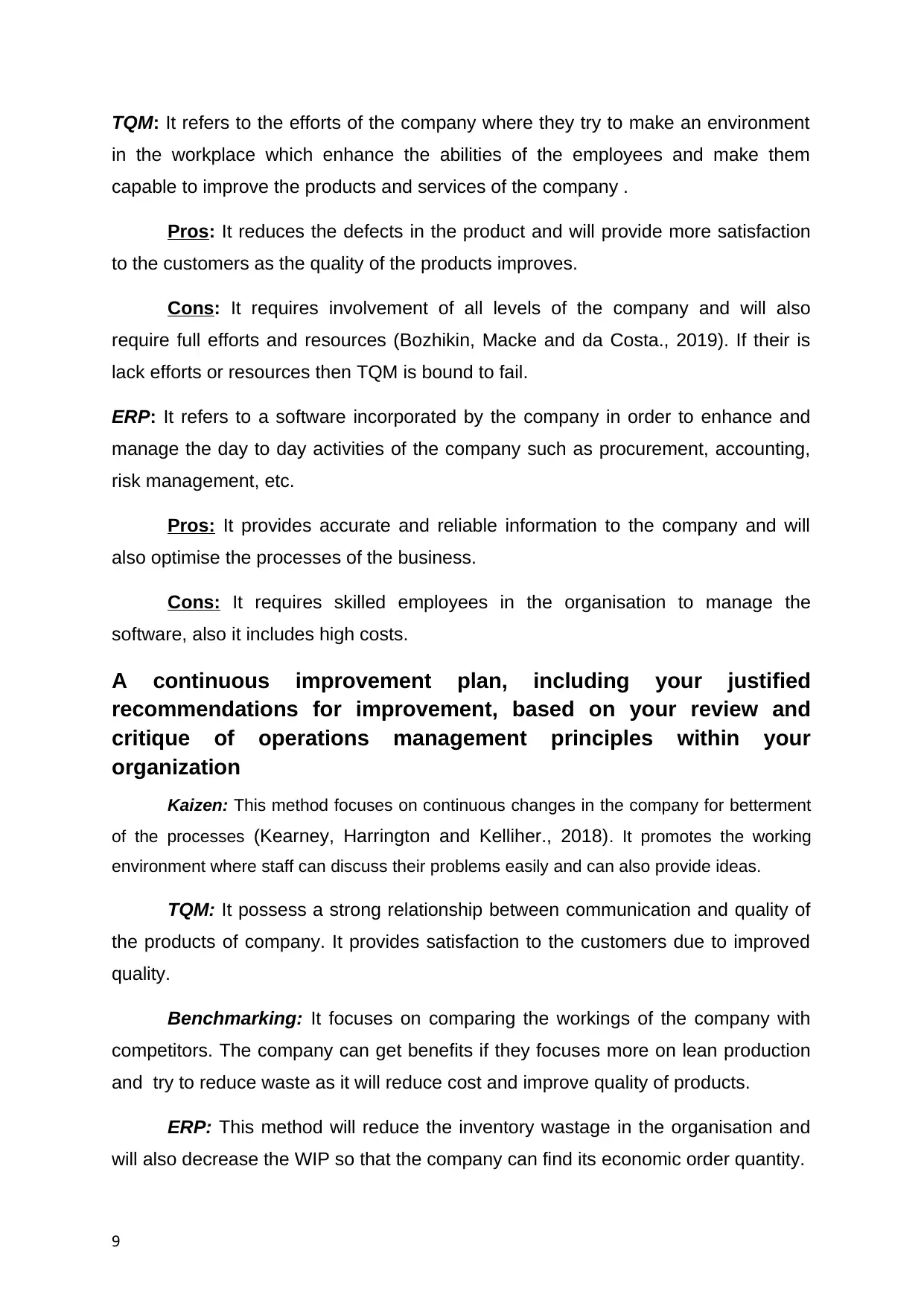
TQM: It refers to the efforts of the company where they try to make an environment
in the workplace which enhance the abilities of the employees and make them
capable to improve the products and services of the company .
Pros: It reduces the defects in the product and will provide more satisfaction
to the customers as the quality of the products improves.
Cons: It requires involvement of all levels of the company and will also
require full efforts and resources (Bozhikin, Macke and da Costa., 2019). If their is
lack efforts or resources then TQM is bound to fail.
ERP: It refers to a software incorporated by the company in order to enhance and
manage the day to day activities of the company such as procurement, accounting,
risk management, etc.
Pros: It provides accurate and reliable information to the company and will
also optimise the processes of the business.
Cons: It requires skilled employees in the organisation to manage the
software, also it includes high costs.
A continuous improvement plan, including your justified
recommendations for improvement, based on your review and
critique of operations management principles within your
organization
Kaizen: This method focuses on continuous changes in the company for betterment
of the processes (Kearney, Harrington and Kelliher., 2018). It promotes the working
environment where staff can discuss their problems easily and can also provide ideas.
TQM: It possess a strong relationship between communication and quality of
the products of company. It provides satisfaction to the customers due to improved
quality.
Benchmarking: It focuses on comparing the workings of the company with
competitors. The company can get benefits if they focuses more on lean production
and try to reduce waste as it will reduce cost and improve quality of products.
ERP: This method will reduce the inventory wastage in the organisation and
will also decrease the WIP so that the company can find its economic order quantity.
9
in the workplace which enhance the abilities of the employees and make them
capable to improve the products and services of the company .
Pros: It reduces the defects in the product and will provide more satisfaction
to the customers as the quality of the products improves.
Cons: It requires involvement of all levels of the company and will also
require full efforts and resources (Bozhikin, Macke and da Costa., 2019). If their is
lack efforts or resources then TQM is bound to fail.
ERP: It refers to a software incorporated by the company in order to enhance and
manage the day to day activities of the company such as procurement, accounting,
risk management, etc.
Pros: It provides accurate and reliable information to the company and will
also optimise the processes of the business.
Cons: It requires skilled employees in the organisation to manage the
software, also it includes high costs.
A continuous improvement plan, including your justified
recommendations for improvement, based on your review and
critique of operations management principles within your
organization
Kaizen: This method focuses on continuous changes in the company for betterment
of the processes (Kearney, Harrington and Kelliher., 2018). It promotes the working
environment where staff can discuss their problems easily and can also provide ideas.
TQM: It possess a strong relationship between communication and quality of
the products of company. It provides satisfaction to the customers due to improved
quality.
Benchmarking: It focuses on comparing the workings of the company with
competitors. The company can get benefits if they focuses more on lean production
and try to reduce waste as it will reduce cost and improve quality of products.
ERP: This method will reduce the inventory wastage in the organisation and
will also decrease the WIP so that the company can find its economic order quantity.
9
⊘ This is a preview!⊘
Do you want full access?
Subscribe today to unlock all pages.

Trusted by 1+ million students worldwide
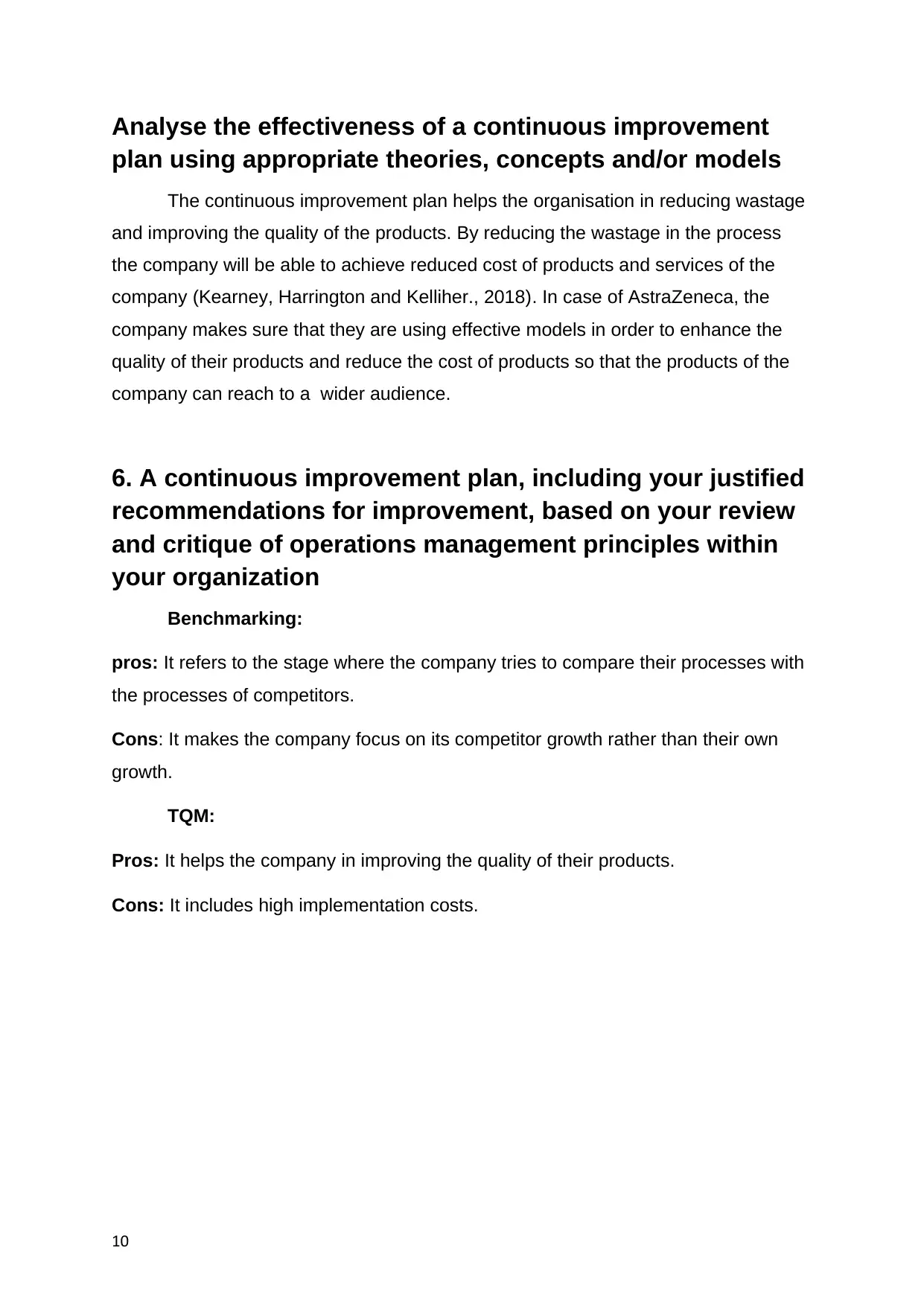
Analyse the effectiveness of a continuous improvement
plan using appropriate theories, concepts and/or models
The continuous improvement plan helps the organisation in reducing wastage
and improving the quality of the products. By reducing the wastage in the process
the company will be able to achieve reduced cost of products and services of the
company (Kearney, Harrington and Kelliher., 2018). In case of AstraZeneca, the
company makes sure that they are using effective models in order to enhance the
quality of their products and reduce the cost of products so that the products of the
company can reach to a wider audience.
6. A continuous improvement plan, including your justified
recommendations for improvement, based on your review
and critique of operations management principles within
your organization
Benchmarking:
pros: It refers to the stage where the company tries to compare their processes with
the processes of competitors.
Cons: It makes the company focus on its competitor growth rather than their own
growth.
TQM:
Pros: It helps the company in improving the quality of their products.
Cons: It includes high implementation costs.
10
plan using appropriate theories, concepts and/or models
The continuous improvement plan helps the organisation in reducing wastage
and improving the quality of the products. By reducing the wastage in the process
the company will be able to achieve reduced cost of products and services of the
company (Kearney, Harrington and Kelliher., 2018). In case of AstraZeneca, the
company makes sure that they are using effective models in order to enhance the
quality of their products and reduce the cost of products so that the products of the
company can reach to a wider audience.
6. A continuous improvement plan, including your justified
recommendations for improvement, based on your review
and critique of operations management principles within
your organization
Benchmarking:
pros: It refers to the stage where the company tries to compare their processes with
the processes of competitors.
Cons: It makes the company focus on its competitor growth rather than their own
growth.
TQM:
Pros: It helps the company in improving the quality of their products.
Cons: It includes high implementation costs.
10
Paraphrase This Document
Need a fresh take? Get an instant paraphrase of this document with our AI Paraphraser
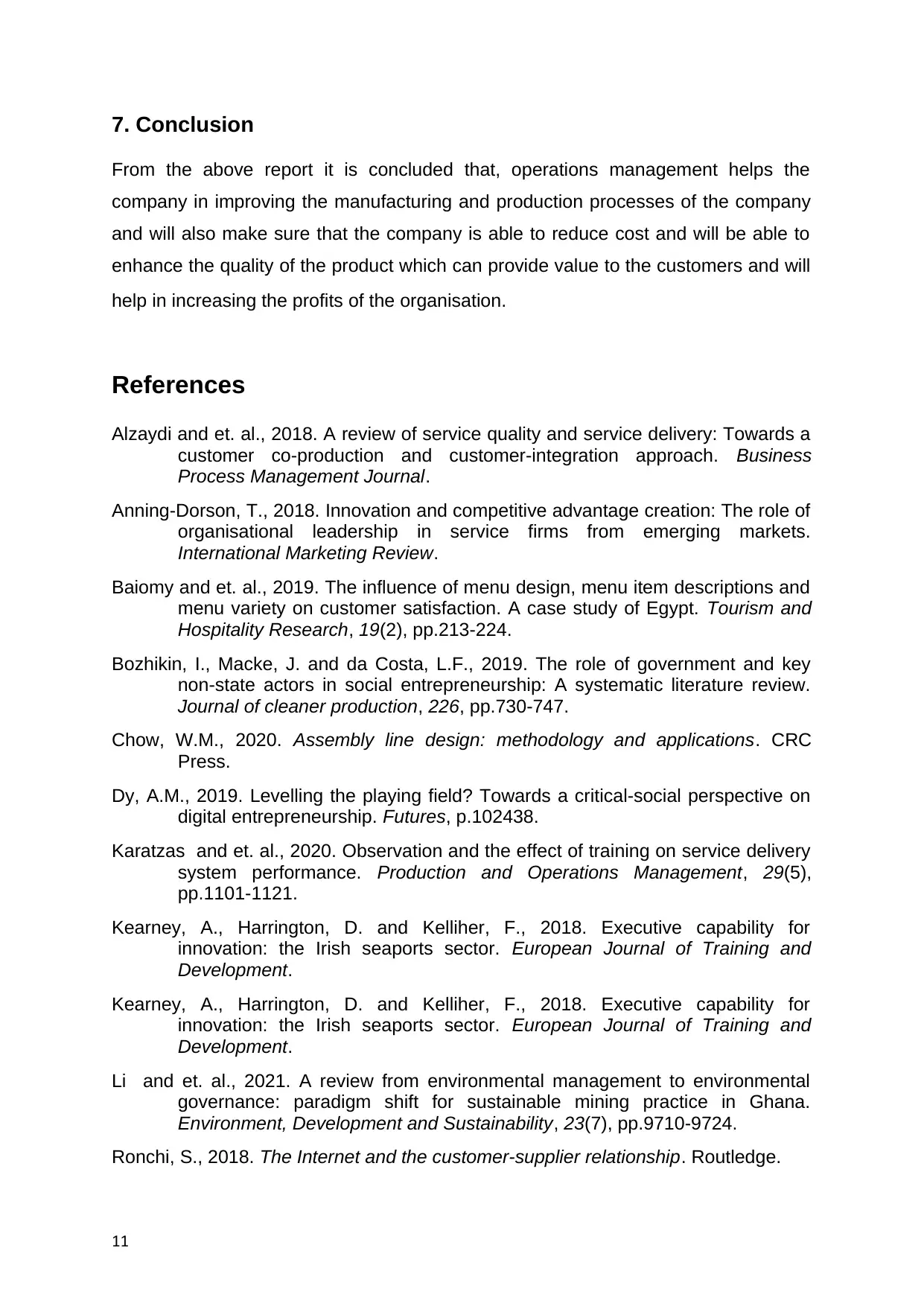
7. Conclusion
From the above report it is concluded that, operations management helps the
company in improving the manufacturing and production processes of the company
and will also make sure that the company is able to reduce cost and will be able to
enhance the quality of the product which can provide value to the customers and will
help in increasing the profits of the organisation.
References
Alzaydi and et. al., 2018. A review of service quality and service delivery: Towards a
customer co-production and customer-integration approach. Business
Process Management Journal.
Anning-Dorson, T., 2018. Innovation and competitive advantage creation: The role of
organisational leadership in service firms from emerging markets.
International Marketing Review.
Baiomy and et. al., 2019. The influence of menu design, menu item descriptions and
menu variety on customer satisfaction. A case study of Egypt. Tourism and
Hospitality Research, 19(2), pp.213-224.
Bozhikin, I., Macke, J. and da Costa, L.F., 2019. The role of government and key
non-state actors in social entrepreneurship: A systematic literature review.
Journal of cleaner production, 226, pp.730-747.
Chow, W.M., 2020. Assembly line design: methodology and applications. CRC
Press.
Dy, A.M., 2019. Levelling the playing field? Towards a critical-social perspective on
digital entrepreneurship. Futures, p.102438.
Karatzas and et. al., 2020. Observation and the effect of training on service delivery
system performance. Production and Operations Management, 29(5),
pp.1101-1121.
Kearney, A., Harrington, D. and Kelliher, F., 2018. Executive capability for
innovation: the Irish seaports sector. European Journal of Training and
Development.
Kearney, A., Harrington, D. and Kelliher, F., 2018. Executive capability for
innovation: the Irish seaports sector. European Journal of Training and
Development.
Li and et. al., 2021. A review from environmental management to environmental
governance: paradigm shift for sustainable mining practice in Ghana.
Environment, Development and Sustainability, 23(7), pp.9710-9724.
Ronchi, S., 2018. The Internet and the customer-supplier relationship. Routledge.
11
From the above report it is concluded that, operations management helps the
company in improving the manufacturing and production processes of the company
and will also make sure that the company is able to reduce cost and will be able to
enhance the quality of the product which can provide value to the customers and will
help in increasing the profits of the organisation.
References
Alzaydi and et. al., 2018. A review of service quality and service delivery: Towards a
customer co-production and customer-integration approach. Business
Process Management Journal.
Anning-Dorson, T., 2018. Innovation and competitive advantage creation: The role of
organisational leadership in service firms from emerging markets.
International Marketing Review.
Baiomy and et. al., 2019. The influence of menu design, menu item descriptions and
menu variety on customer satisfaction. A case study of Egypt. Tourism and
Hospitality Research, 19(2), pp.213-224.
Bozhikin, I., Macke, J. and da Costa, L.F., 2019. The role of government and key
non-state actors in social entrepreneurship: A systematic literature review.
Journal of cleaner production, 226, pp.730-747.
Chow, W.M., 2020. Assembly line design: methodology and applications. CRC
Press.
Dy, A.M., 2019. Levelling the playing field? Towards a critical-social perspective on
digital entrepreneurship. Futures, p.102438.
Karatzas and et. al., 2020. Observation and the effect of training on service delivery
system performance. Production and Operations Management, 29(5),
pp.1101-1121.
Kearney, A., Harrington, D. and Kelliher, F., 2018. Executive capability for
innovation: the Irish seaports sector. European Journal of Training and
Development.
Kearney, A., Harrington, D. and Kelliher, F., 2018. Executive capability for
innovation: the Irish seaports sector. European Journal of Training and
Development.
Li and et. al., 2021. A review from environmental management to environmental
governance: paradigm shift for sustainable mining practice in Ghana.
Environment, Development and Sustainability, 23(7), pp.9710-9724.
Ronchi, S., 2018. The Internet and the customer-supplier relationship. Routledge.
11
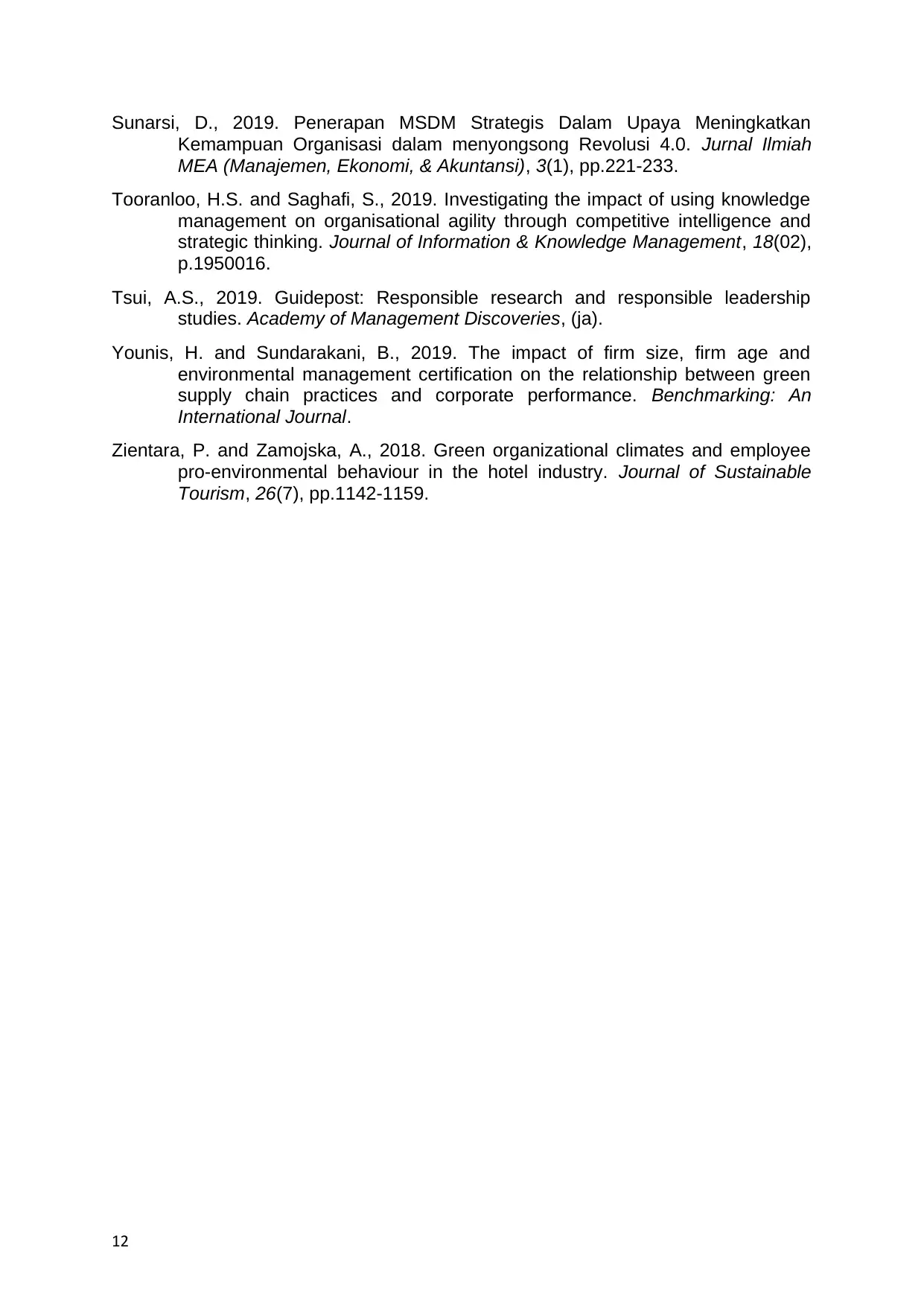
Sunarsi, D., 2019. Penerapan MSDM Strategis Dalam Upaya Meningkatkan
Kemampuan Organisasi dalam menyongsong Revolusi 4.0. Jurnal Ilmiah
MEA (Manajemen, Ekonomi, & Akuntansi), 3(1), pp.221-233.
Tooranloo, H.S. and Saghafi, S., 2019. Investigating the impact of using knowledge
management on organisational agility through competitive intelligence and
strategic thinking. Journal of Information & Knowledge Management, 18(02),
p.1950016.
Tsui, A.S., 2019. Guidepost: Responsible research and responsible leadership
studies. Academy of Management Discoveries, (ja).
Younis, H. and Sundarakani, B., 2019. The impact of firm size, firm age and
environmental management certification on the relationship between green
supply chain practices and corporate performance. Benchmarking: An
International Journal.
Zientara, P. and Zamojska, A., 2018. Green organizational climates and employee
pro-environmental behaviour in the hotel industry. Journal of Sustainable
Tourism, 26(7), pp.1142-1159.
12
Kemampuan Organisasi dalam menyongsong Revolusi 4.0. Jurnal Ilmiah
MEA (Manajemen, Ekonomi, & Akuntansi), 3(1), pp.221-233.
Tooranloo, H.S. and Saghafi, S., 2019. Investigating the impact of using knowledge
management on organisational agility through competitive intelligence and
strategic thinking. Journal of Information & Knowledge Management, 18(02),
p.1950016.
Tsui, A.S., 2019. Guidepost: Responsible research and responsible leadership
studies. Academy of Management Discoveries, (ja).
Younis, H. and Sundarakani, B., 2019. The impact of firm size, firm age and
environmental management certification on the relationship between green
supply chain practices and corporate performance. Benchmarking: An
International Journal.
Zientara, P. and Zamojska, A., 2018. Green organizational climates and employee
pro-environmental behaviour in the hotel industry. Journal of Sustainable
Tourism, 26(7), pp.1142-1159.
12
⊘ This is a preview!⊘
Do you want full access?
Subscribe today to unlock all pages.

Trusted by 1+ million students worldwide
1 out of 23
Related Documents
Your All-in-One AI-Powered Toolkit for Academic Success.
+13062052269
info@desklib.com
Available 24*7 on WhatsApp / Email
![[object Object]](/_next/static/media/star-bottom.7253800d.svg)
Unlock your academic potential
Copyright © 2020–2025 A2Z Services. All Rights Reserved. Developed and managed by ZUCOL.


